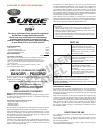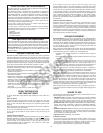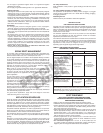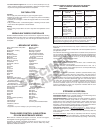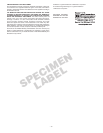
SPECIMEN
LABEL
– 4 –
– BROADLEAF WEEDS –
Aster, white heath & white prairie
B
edstraw
Beggarweed, creeping
Bindweed
Black medic
Broadleaf plantain
Buckhorn plantain
Bull thistle
Burdock, common
Buttercup, creeping
Carpetweed
Chickweed, common
Chicor
y
Cinquefoil
Clover
Curly dock
Dandelion
Dayflower
Deadnettle
Dock
Dogfennel
Dollarweed (*pennywort)
False dandelion (*spotted catsear
& common catsear)
Field bindw
eed (*mor
ningglory
& creeping jenny)
Field o
x
e
y
e-daisy (*creeping oxeye)
Filaree, whitestem & redstem
Flor
ida beton
y
Florida pusley
Ground ivy
Groundsel
Hawkweed
Healall
Henbit
Innocence (Blue-eyed Mary)
Knotweed
Lambsquar
ters
Lawn burweed
Lespedeza, common
Mallow, common
M
atchweed
Mouseear chickweed
Nutsedge** (yellow)
Old world diamond flower
Oxalis (*yellow woodsorrel
& creeping woodsorrel)
Parsley-piert
Pennsylvania smartweed
Pepperweed
Pigweed
Pineappleweed
Plantain
Poison ivy
Poison oak
Prickly lettuce (*compass plant)
Puncturevine
Purple cudweed
Purslane
Ragweed
Redweed
Red sorrel (*sheep sorrel)
Shepherdspurse
Spurge
Thistle
Virginia buttonweed
White clo
v
er (*Dutch clo
v
er,
honeysuckle clover,
white tref
oil, & pur
ple
wort)
Wild carrot
Wild garlic
Wild geranium
Wild lettuce
Wild mustard
Wild onion
Wild strawberry
Yarrow
Y
ello
w roc
ket
and many more broadleaf weeds
*Synonyms
**Suppression only when n
utsedge is y
oung and activ
ely growing.
TOUGH WEED CONTROL IN INDUSTRIAL
OR LOW MAINTENANCE AREAS
Mixed stands of Kentucky bluegrass, tall fescue, smooth bromegrass,
orchardg
r
ass and reed canar
ygrass may be treated.
Treatments of SURGE
®
Broadleaf Herbicide For Turf may injure or kill
legumes including clovers (sweet, yellow, red, crimson, alsike, hop, white),
lespedezas, trefoils and vetches.
TABLE 2. RATES OF PRODUCT PER ACRE FOR SPECIFIC
HARD-TO-CONTROL WEEDS WITH GROUND
EQUIPMENT.
Weed Types
T
roublesome Weeds
S
uch As:
Amount of
Product,
P
ints/Acre
1
When to Apply
A
nnual
Broadleaf
Biennial
P
erennial
I
vyleaf morningglory,
redroot pigweed,
cocklebur, sunflower,
v
elvetleaf (butterprint)
Bull thistle, musk
t
histle, common
b
urdock
B
urclover, Canada
t
histle, field
bindweed, English
daisy, hoary cress
(
whitetop),
V
eronica
(
corn speedwell),
wild violet.
2
.5-4.0
pints/acre
4.0-5.0
p
ints/acre
4
.0-5.0
p
ints/acre
S
pring or fall during
active growth.
Spring or fall during
s
eedling to rosette
s
tage.
S
pring or fall during
b
ud to bloom
stage.
F
ootnote 1:
U
se the lower rate within the range specified for highly favorable plant
growing conditions and when broadleaf weeds are less than 6 inches in height.
Use the higher rate within the range specified for tall vegetation, dense canopies,
w
eeds beyond the suggested growth stage, or during adverse conditions.
•
For warm-season turfgrass: Mix 1.0-1.2 fl. oz. of this product per one (1.0)
gallon of water for treatment of approximately 1,000 sq.ft of turfgrass. Apply
any time the emerged broadleaf weeds are susceptible.
C
ULTURAL TIPS
Irrigation:
• Do not apply this product through any type of irrigation system.
• Rainfast in as little as 6 hours. Do not apply this product immediately
before rainfall or irrigation.
• If possible, do not irrigate or water the turfgrass within 6 to 24 hours after
application.
• If dry conditions exist, a scheduled irrigation or watering 24 hours before
and 24 hours after application is recommended.
Mowing:
• Delay mowing 2 days before and until 2 days after the application of this
product.
BROADLEAF WEEDS CONTROLLED
SURGE
®
Broadleaf Herbicide For Turf will control or suppress the following
broadleaf weeds and will control or suppress broadleaf weeds that are
susceptible to 2,4-D. Apply any time the emerged broadleaf weeds are
s
usceptible.
B
iennial and perennial weeds may require follow-up or sequential
treatments.
T
he maxim
u
m application rate is 0.9 pounds 2,4-D acid equivalent per acre
per application per site.
The maximum seasonal rate of sulfentrazone contained in this product with
two (2) broadcast applications to turfgrass is 0.074 pounds of sulfentrazone
per acre per season.The retreatment interval for sequential broadcast appli-
cations of this product on turfgrass is two (2) to six (6) weeks depending
upon the growth stages of the target weeds.
Spray volumes with ground equipment:
• For SURGE
®
Broadleaf Herbicide For Turf alone, use a minimum spray
volume of 10.0 gallons per acre (gpa).
• For tank mixtures of SURGE
®
Broadleaf Herbicide For Turf, use a
minimum spray volume of 20.0 gallons per acre or use the specified spray
volume of the companion product(s).
Adjuvants:
The addition of adjuvants (surfactants, spreaders, spreader-stickers, spray
thic
keners, foaming agents activators, detergents, and drift reducing
agents,) is not necessary when using this product. Under extreme environ-
mental conditions such as drought, the addition of a surfactant may improve
efficacy. However, if the foliar phytotoxicity (leaf burn and necrosis) occurs
too quic
kly, then the translocation of SURGE
®
Broadleaf Herbicide F
or Turf
will not occur and the level of performance (control) may be reduced in
perennial broadleaf weeds. Do not use adjuvants and spray additive
tank-mix combinations, unless your experience indicates that the tank
mixture will not result in turf injury.
STORAGE & DISPOSAL
Do not contaminate water, food, or feed by storage or disposal.
PESTICIDE STORAGE: Store in original container in a locked storage area
inaccessib
le to children or pets
.
Keep from freezing.
PESTICIDE DISPOSAL: Pesticide wastes are acutely hazardous. Improper
disposal of excess pesticide, spray mixture, or rinsate is a violation of
Federal law and may contaminate groundwater. If these wastes cannot be
disposed of by use according to label instructions, contact your state
Pesticide or Environmental Control Agency or the Hazardous Waste
representativ
e at the nearest EP
A Regional Office for guidance.
CONTAINER DISPOSAL: For Metal Containers - Triple rinse (or
equivalent). Then offer for recycling or reconditioning, or puncture and dis-
pose of in a sanitary landfill, or by other procedures approved by state and
local authorities.
For Plastic Containers - Triple rinse (or equivalent). Then offer for recycling
or reconditioning, or puncture and dispose of in a sanitar
y landfill, or inciner
-
ation, or if allowed by state and local authorities by burning. If burned stay
out of smoke.



